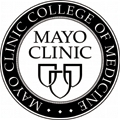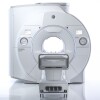Mayo Clinic Develops Medical Device That Reduces the Need for Invasive Surgical Biopsy Procedures
by Barbara Kram, Editor | January 03, 2007

The Mayo Clinic has
developed an interactive
Breath-hold Control device.
developed an interactive
Breath-hold Control device.
ROCHESTER, Minn. -- Mayo Clinic has developed a new medical device that will help patients control their breathing (respiratory motion) when undergoing computed tomographic (CT) fluoroscopy-guided biopsies. The Interactive Breath-hold Control will be the first medical device of its kind in the world. The device will allow physicians to more rapidly and accurately diagnose patients reducing the need for a more invasive surgical biopsy. Clinical trials of the Interactive Breath-hold Control were conducted at Mayo Clinic in Rochester, Minn., and in Munich, Germany. Mayo Clinic and a hospital in Munich are currently using the device.
The Interactive Breath-hold Control device measures the breathing of the patient using a simple light display. The wireless display device, which is about the size of a handheld video game, consists of a simple belt with expandable bellows that are wrapped around a patient's upper abdomen or lower chest, individual light displays located next to the patient, the radiologist's image monitor, the CT operator console, and a system control unit located next to the patient on the CT table.
"By focusing on the display, patients can easily adjust their breathing and consistently reproduce the same reference breath-hold level," says Stephanie Carlson, M.D., a Mayo Clinic radiologist and lead investigator of the project. "This allows the radiologist to conduct a more accurate and safe procedure in less time than if the target area of the lesion were moving."
Prior to the development of this device, CT-guided biopsies were more difficult for radiologists and patients because respiratory motion and inconsistent breath holding by the patients could obscure the exact target area of a lesion and cause the target nodule to move out of the field of view during the procedure, particularly if the lesions are small or in difficult to reach locations.
The Interactive Breath hold Control allows radiologists to perform biopsies on smaller and more difficult to access nodules during a 30- to 45-minute CT-guided procedure. The patient can return home the same day with nothing more than a Band-aid. In the past, difficult lung biopsies would require a surgical procedure resulting in a two- to four-day stay in the hospital.
The Interactive Breath-hold Control has significant advantages over the traditional procedure.
These include:
* Increased patient care and comfort
* Increase in safety
* Potential decrease in health care expenses for patients, by avoiding the need for more invasive and costly surgical biopsy procedures
The Interactive Breath-hold Control device measures the breathing of the patient using a simple light display. The wireless display device, which is about the size of a handheld video game, consists of a simple belt with expandable bellows that are wrapped around a patient's upper abdomen or lower chest, individual light displays located next to the patient, the radiologist's image monitor, the CT operator console, and a system control unit located next to the patient on the CT table.
"By focusing on the display, patients can easily adjust their breathing and consistently reproduce the same reference breath-hold level," says Stephanie Carlson, M.D., a Mayo Clinic radiologist and lead investigator of the project. "This allows the radiologist to conduct a more accurate and safe procedure in less time than if the target area of the lesion were moving."
Prior to the development of this device, CT-guided biopsies were more difficult for radiologists and patients because respiratory motion and inconsistent breath holding by the patients could obscure the exact target area of a lesion and cause the target nodule to move out of the field of view during the procedure, particularly if the lesions are small or in difficult to reach locations.
The Interactive Breath hold Control allows radiologists to perform biopsies on smaller and more difficult to access nodules during a 30- to 45-minute CT-guided procedure. The patient can return home the same day with nothing more than a Band-aid. In the past, difficult lung biopsies would require a surgical procedure resulting in a two- to four-day stay in the hospital.
The Interactive Breath-hold Control has significant advantages over the traditional procedure.
These include:
* Increased patient care and comfort
* Increase in safety
* Potential decrease in health care expenses for patients, by avoiding the need for more invasive and costly surgical biopsy procedures
1(current)









